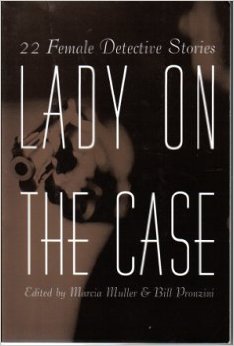
The original Lady on the Case was published in 1988. I have the Barnes & Noble edition that was published in 2000. Lady on the Case: 22 Female Detective Stories shows the evolution of the female detective from the gifted amateur to the professional detective. Of course, Agatha Christie’s Miss Marple is here, so are Sue Grafton’s Kinsey Millhone and Sara Paretsky’s V. I. Warshawski. I enjoyed the compete Miss Hildegarde Withers novel (she’s a Miss Marple clone but a good one). Inexpensive copies of this excellent anthology can be found online for a pittance. You’ll find over 500 pages of entertaining writing in Lady on the Case.
TABLE OF CONTENTS
Introduction
“The Murder at Troyte’s Hill” by C. L. Pirkis
“The Man in the Inverness Cape” by Baroness Orczy
“Death in the Sun” by G.D. H. and Margaret Cole
“The Second Bullet” by Anna Katharine Green
“The Stripper” by Anthony Boucher
“The Claret Stick” Mignon Eberhart
“The Four Suspects” by Agatha Christie
“The Broken Men” by Marcia Muller
“The Invisible Intruder” by Edward D. Hoch
“A Date in Helsinki” Patricia McGerr
“The Dancing Detective” by Cornell Woolrich
“Lucky Penny” by Linda Barnes
“The Fuzzy Things” by D. B. Olsen
“Coyote and Quarter-Moon” by Bill Pronzini & Jeffrey Wallmann
“At the Old Swimming Hole” by Sara Paretsky
“Mom Sheds a Tear” James Yaffe
“Dairy Bell” by Gladys Mitchell
“Solo Job” by Paul Gallico
“Not Before My Morning Coffee” by Susan Dunlap
“Mrs. Norris Observes” by Dorothy Salisbury Davis
“The Parker Shotgun” by Sue Grafton
“Murder on Wheels: A Novel” by Stuart Palmer
Sounds like a great collection – buit harsh on Hildegarde Withers though – her first book came out only a few months after the first Marple I think and I could never get the two mixed up!
Sergio, I enjoyed LADY ON THE CASE. Plenty of clever detecting and suspense!
I liked the book very much and the Withers novel was one of my favorite parts.
Jerry, no one mentions Hildegarde Withers much anymore. She’s a very underrated sleuth!
I’m surprised to realize I didn’t read this one. I’ll have to look for a copy. I used to like the Miss Withers movies with Edna May Oliver and James Gleason. Doug Greene did a collection of Withers stories for Crippen & Landru.
Jeff, you’ll enjoy LADY ON THE CASE. I have that Crippen & Landru collection, but it’s buried in my Read Real Soon pile.
I, too, was brought up short by the description of Hildegarde Withers as a “Miss Marple clone”. Your words, or the Mullzini’s? As Sergio notes, the two characters appeared almost simultaneously (Murder at the Vicarage 1930, Penguin Pool Murder 1931) and, apart from both being spinsters poking their noses into murders, the two characters are very different (as different as Edna Mae Oliver and Joan Hickson, in fact). There’s a quotation from Palmer on Steven Saylor’s website about the genesis of Hildy. Palmer says she started out as a minor comic relief character in Penguin Pool who wound up taking over the story. The character was inspired by Palmer’s high school English teacher; Marple is not mentioned.
Art, I suspect I was infected by Mulzini’s description of Hildegarde Withers as a Miss Marple clone. They are both canny senior citizens solving murders. But, as you and Sergio point out, they are different characters. I’ll have to check out Steven Saylor’s website for the genesis of Hildy. The late lamented Pyramid Green Door Mystery series introduced me to Hildgarde Withers long long ago.
Read this a while back. Mostly pretty good stories. Not fond of either Hildegarde or Miss Marple. The only thing worse than old ladies solving crimes are women solving crimes accompanied by their cats.
Steve, I’m not fond of cats (or any pets) solving crimes, too.
I’ll take Marple or Withers over Philo Vance every day of the week. It was an interesting selection, highlighting some writers and characters that don’t normally get representation in similar books.
Todd, I’m a big fan of the Muller & Pronzini anthologies. They always make intelligent and unexpected selections.
Wrapping with a novel also made the book feel a bit like an “Alfred Hitchcock Presents:” or an Ellery Queen anthology…
Todd, you’re right about ending a collection with a novel. You don’t see that done much anymore.
I’ve always wondered about the fact that, though female, I’ve always been more drawn to male detectives. Even my favorite female writers tend to write male characters (Ruth Rendell, Patricia Highsmith). Maybe it’s an escapist thing.